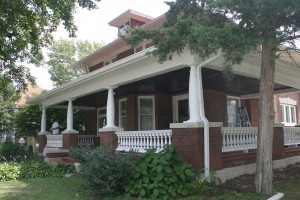Recently, I told the history of the former home of a prominent Monmouth family that has been renovated by Monmouth College and today serves as its admissions building. In this blog, I move across the street to another brick house on the corner with a similar story—The Manor.
The official presidential home during the James Harper Grier and Robert W. Gibson administrations, the house had been the longtime residence of Monmouth College trustee Fred Burleigh Pattee before it was purchased by the college in 1949.
A notable example of American Foursquare architecture, the elegant brick building at 701 East Broadway was erected shortly after the turn of the 20th century by Charles A. Perley, general superintendent of Monmouth’s Pattee Plow Company. Fred B. Pattee, whose father and uncle had founded the plow company, purchased the home from Perley in 1908, just two weeks prior to his marriage to Miss Mary Hardin, daughter of Monmouth industrialist Delevan Hardin. After a brief honeymoon, the couple set up housekeeping.
The Pattees and Hardins were arguably Monmouth’s two most prominent families. Fred’s father, J. Howard Pattee, had invented the first tongueless cultivator in 1872. His New Departure Cultivator revolutionized agriculture and helped open up the western territories. Mary’s grandfather, Chauncy Hardin, was one of the builders of the C.B. & Q. Railroad. Her father, Delevan, had been president of both the Weir Pottery Company and the Second National Bank.
In 1913, Mary gave birth to their only child, Frederick H. Pattee, who grew up in the house and, after graduating from M.I.T., continued to live there with his parents—even after his marriage in 1941 to Martha Salladay. Mary died in 1944, but her husband, son and daughter-in-law remained in the house until 1949, when they built a modern ranch-style house at 1335 East Broadway. That year, Fred H. joined the MC board of trustees, and the college Senate voted to purchase the former Pattee house to replace the aging “Woodbine Cottage,” which had served as the presidential manse since World War I days. Requiring a name befitting the home of presidents, the Pattee house was dubbed “The Manor.”
President and Mrs. Grier moved into the home that fall. Three years later, President and Mrs. Robert W. Gibson took up residence and would make The Manor their home until the end of their presidency in 1964. In 1965, the newly-inaugurated President Duncan Wimpress moved into the new presidential home, Quinby House. The Manor was converted into a home for senior women. In the fall of 1968, it became home to a new fraternity chapter, Phi Epsilon Phi, which the following year obtained a national charter with Zeta Beta Tau. In a bit of historic irony, the ZBTs in 1975 relocated to the former presidential manse—Woodbine Cottage—leaving The Manor temporarily vacant.
Between 1976 and 1979, The Manor was rented to Professor Rod Lemon’63 and his wife, Hallie Simpson’63 Lemon. In 1980, the college relations office moved in and remained there until 1996, when the renovation of Carnegie Library into Poling Hall created additional office space and the house was no longer needed for that purpose. Dick Valentine, MC’s then vice president for external relations, and his wife, Lorna, purchased the property that year and converted it back to a private residence. The Valentines conducted extensive renovations to the property, which over the years had become somewhat worn, and they also constructed a three-car garage in back.
In 2004, the former Manor went on the market again. Monmouth College trustee Bonnie Bondurant Shaddock, a 1954 graduate, still had fond memories of The Manor, having visited Presidents Grier and Gibson there while a student. The former president of Monmouth’s Alpha Chapter of Kappa Kappa Gamma, she was also proud of the Pattee family’s ties to the founding of the women’s fraternity—the elder Fred Pattee’s aunt and cousin having been among its earliest members. Bonnie and her husband, Shad, decided to purchase the now-renovated property and present it as a gift to her alma mater to be used as a comfortable guest house.
The Manor officially began its second life with Monmouth College on May 13, 2006, when a dedication ceremony was held during Commencement weekend. Today, it is regularly occupied by guests, from prospective faculty members to distinguished visiting lecturers.

